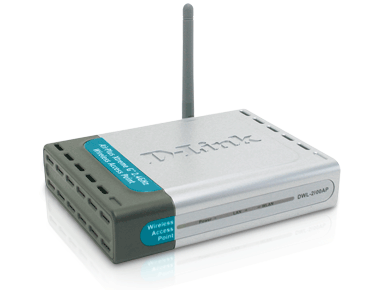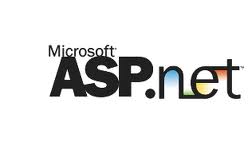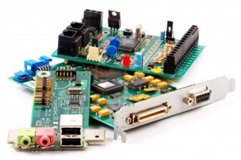

Access Point
An access point provides wireless access to a network. Devices connected to an access point can communicate with other devices on the network. They may also connect to the Internet if the access point is linked to an Internet connection, which is commonly the case. Access points that use Wi-Fi are also called base stations.
Example: "The coffee shop provides an access point for customers with Wi-Fi devices."

ACL
Stands for "Access Control List." An ACL is a list of user permissions for a file, folder, or other object. It defines what users and groups can access the object and what operations they can perform. These operations typically include read, write, and execute. For example, if an ACL specifies read-only access for a specific user of a file, that user will be able open the file, but cannot write to it or run the file.
ActiveX
This Microsoft-based technology was built to link desktop applications to the World Wide Web. Using ActiveX development tools, software developers can create interactive Web content for their applications. For example, Word and Excel documents can be viewed directly in Web browsers that supports ActiveX. While ActiveX is a useful technology, the downside is that you need to have a up-to-date version ActiveX installed on your machine in order to use ActiveX-enabled content.
Ad Hoc Network
"Ad Hoc" is actually a Latin phrase that means "for this purpose." It is often used to describe solutions that are developed on-the-fly for a specific purpose. In computer networking, an ad hoc network refers to a network connection established for a single session and does not require a router or a wireless base station.
For example, if you need to transfer a file to your friend's laptop, you might create an ad hoc network between your computer and his laptop to transfer the file. This may be done using an Ethernet crossover cable, or the computers' wireless cards to communicate with each other. If you need to share files with more than one computer, you could set up a mutli-hop ad hoc network, which can transfer data over multiple nodes.
Basically, an ad hoc network is a temporary network connection created for a specific purpose (such as transferring data from one computer to another). If the network is set up for a longer period of time, it is just a plain old local area network (LAN).
ADC
Stands for "Analog-to-Digital Converter." Since computers only process digital information, they require digital input. Therefore, if an analog input is sent to a computer, an analog-to-digital converter (ADC) is required. This device can take an analog signal, such as an electrical current, and digitize it into a binary format that the computer can understand.
A common use for an ADC is to convert analog video to a digital format. For example, video recorded on 8mm film or a VHS tape is stored in an analog format. In order to transfer the video to a computer, the video must be converted to a digital format. This can be done using an ADC video conversion box, which typically has composite video inputs and a Firewire output. Some digital camcorders that have analog inputs can also be used to convert video from analog to digital.
ADCs may also be used to convert analog audio streams. For example, if you want to record sounds from a microphone, the audio must be converted from the microphone's analog signal into a digital signal that the computer can understand. This is why all sound cards that have an analog audio input also require an ADC that converts the incoming audio signal to a digital format. The accuracy of the audio conversion depends on the sampling rate used in the conversion process. Higher sampling rates provide a better estimation of the analog signal, and therefore produce a higher-quality sound.
While ADCs convert analog inputs into a digital format that computers can recognize, sometimes a computer must output an analog signal. For this type of conversion, a digital-to-analog converter (DAC) is used.
Add-on
An add-on is a software extension that adds extra features to a program. It may extend certain functions within the program, add new items to the program's interface, or give the program additional capabilities. For example, Mozilla Firefox, a popular Web browser, supports add-ons such as the Google toolbar, ad blockers, and Web developer tools. Some computer games support add-ons that provide extra maps, new characters, or give the player game-editing capabilities.
Most add-ons are available as self-installing packages. This means the user can simply double-click the add-on package to install the files for the corresponding program. Other add-ons may require the user to manually move files into specific directories. While not all programs support add-ons, many programs are now developed with add-on support, since it provides a simple way for other developers to extend the functions of the program.
However, not all software programs refer to these extra features as "add-ons." For example, Dreamweaver supports "extensions," which add extra Web development features, while Excel can import "Add-Ins" that provide the user with extra spreadsheet tools. Many programs also support plug-ins, which may be considered a type of add-on.
ADSL
Stands for "Asymmetric Digital Subscriber Line." ADSL is a type of DSL, which is a method of transferring data over copper telephone lines. While symmetrical DSL (SDSL) uploads and downloads data at the same speed, ADSL has different maximum data transfer rates for uploading and downloading data.
For example, an ADSL connection may allow download rates of 1.5Mbps, while upload speeds may only reach 256Kbps. Since most users download much more data than they upload, this difference usually does not make a noticeable impact on Internet access speeds. However, for Web servers or other computers that send a lot of data upstream, ADSL would be an inefficient choice.
AGP
Stands for "Accelerated Graphics Port." This is a graphics card expansion port designed by Intel that resides on the motherboard of a computer. PCI graphics ports typically run at 33 MHz and have a maximum transfer rate of 132 MB/sec. AGP ports, on the other hand, run at 66 MHz and can transfer data up to 528 MB/sec. This allows games and applications to store and retrieve larger, more realistic 3D shapes and textures without slowing down the animation on the screen. Additionally, AGP cards can store graphics in system memory rather than video memory, which also helps improve performance. Becuase of these advantages, AGP cards will typically have better performance per MB of VRAM than PCI graphics cards.
AIFF
Stands for "Audio Interchange File Format." AIFF is an audio format originally developed by Apple Computer for storing high-quality sampled audio data. AIFF files are similar to Windows WAVE files in both size and quality. Both AIFF and WAVE files can hold CD quality audio and therefore can be burned onto an audio CD. Though the AIFF format was created by Apple, audio programs on both the Mac and PC can typically read the files.
Alert Box
An alert box, sometimes called a message box, is a small window that pops up on your screen to warn you that your computer is about to perform an operation with potentially damaging consequences. For example, when you choose to empty the Trash or Recycle Bin on your computer, an alert box may pop up, saying "Are you sure you want to permanently remove these items?" You are then given the choice to select "OK," to delete the items, or "Cancel," to prevent the items from being removed.

Alert boxes act as a safeguard for users, preventing us from doing things we wish we hadn't. Perhaps the most common alert box is the one that pops up when you try to close a document without saving it. You'll mostly likely see an alert box with the message, "Save changes to this document before closing?" You can select "Don't Save," to discard the changes, "Save," to save the changes before closing the document, or "Cancel," to cancel closing the document and continue working on it.
Most alert boxes include the standard alert icon -- a triangle with an exclamation point in the middle -- to get your attention. However, not all alert boxes have multiple options, such as "Cancel" and "OK." For example, an alert box may show up on your screen saying a program performed an illegal operation and has unexpectedly quit. When that happens, your only option is to select "OK" and then kick your computer for quitting the program before you had a chance to save your work.
Algorithm
An algorithm is a set of instructions, sometimes called a procedure or a function, that is used to perform a certain task. This can be a simple process, such as adding two numbers together, or a complex function, such as adding effects to an image. For example, in order to sharpen a digital photo, the algorithm would need to process each pixel in the image and determine which ones to change and how much to change them in order to make the image look sharper.
Most computer programmers spend a large percentage of their time creating algorithms. (The rest of their time is spent debugging the algorithms that don't work properly.) The goal is to create efficient algorithms that do not waste more computer resources (such as RAM and CPU time) than necessary. This can be difficult, because an algorithm that performs well on one set of data may perform poorly on other data.
As you might guess, poorly written algorithms can cause programs to run slowly and even crash. Therefore, software updates are often introduced, touting "improved stability and performance." While this sounds impressive, it also means that the algorithms in the previous versions of the software were not written as well as the could have been.
Analog
As humans, we perceive the world in analog. Everything we see and hear is a continuous transmission of information to our senses. This continuous stream is what defines analog data. Digital information, on the other hand, estimates analog data using only ones and zeros.
For example, a turntable (or record player) is an analog device, while a CD player is digital. This is because a turntable reads bumps and grooves from a record as a continuous signal, while a CD player only reads a series of ones and zeros. Likewise, a VCR is an analog device, while a DVD player is digital. A VCR reads audio and video from a tape as a continuous stream of information, while a DVD player just reads ones and zeros from a disc.
Since digital devices read only ones and zeros, they can only approximate an audio or video signal. This means analog data is actually more accurate than digital data. However, digital data can can be manipulated easier and preserved better than analog data. More importantly, computers can only handle digital data, which is why most information today is stored digitally. But if you want to transfer video from old analog video tapes into your computer so you can edit them, you're not out of luck. You can use a digital to analog converter (DAC) to convert the analog information into a digital signal that can be recognized by your computer.
Android
Android is Google's mobile operating system (OS) that is used by several smartphones, such as the G1, Droid, and Nexus One. Android is open source, meaning it is not linked to a specific cell phone manufacturer or service provider. The Android OS also supports third-party applications, which can be downloaded from Android Market, Google's online software store.
Example: "The Android operating system can be customized for each mobile device."

ANSI
Stands for "American National Standards Institute." ANSI's primary goal is to enhance the global competitiveness of U.S. businesses and to improve the American quality of life by promoting and facilitating voluntary consensus standards and conformity assessment systems. "Voluntary" standards are driven by marketplace needs rather than regulated by the government. "Conformity assessment systems" test the compliance of a product or service to a standard. ANSI does not itself develop standards or conduct tests, rather it facilitates this work by "accrediting" (i.e., recognizing) qualified groups with appropriate expertise. The Institute is the official U.S. representative to the International Organization for Standardization (ISO) and the International Electrotechnical Commission (IEC). ANSI is a private, nonprofit membership organization with offices in Washington, DC and New York City.

API
Stands for "Application Program Interface," though it is sometimes referred to as an "Application Programming Interface." An API is a set of commands, functions, and protocols which programmers can use when building software for a specific operating system. The API allows programmers to use predefined functions to interact with the operating system, instead of writing them from scratch.
All computer operating systems, such as Windows, Unix, and the Mac OS, provide an application program interface for programmers. APIs are also used by video game consoles and other hardware devices that can run software programs. While the API makes the programmer's job easier, it also benefits the end user, since it ensures all programs using the same API will have a similar user interface.
Apple
Apple is the company that makes Macintosh computers, such as the iMac, Mac mini, MacBook, MacBook Air, MacBook Pro, and Mac Pro. Apple also makes several personal electronic devices, including the iPod, iPhone, and iPad.

While Apple is most known for its hardware devices, the company also develops a wide range of software. Examples include the Mac OS X operating system, iLife, iWork, and several professional media applications, such as Aperture, Logic Studio, and Final Cut Studio.
Apple has also expanded its reach online with the iTunes Store, App Store, and the new Mac App Store. These services allow you to download media and applications directly to your computer. Apple also has over 300 retail stores worldwide, which offer Apple products and provide Apple product support.
Applet
This a Java program that can be embedded in a Web page. The difference between a standard Java application and a Java applet is that an applet can't access system resources on the local computer. System files and serial devices (modems, printers, scanners, etc.) cannot be called or used by the applet. This is for security reasons -- nobody wants their system wiped out by a malicious applet on some wacko's Web site. Applets have helped make the Web more dynamic and entertaining and have given a helpful boost to the Java programming language.
Application
An application, or application program, is a software program that runs on your computer. Web browsers, e-mail programs, word processors, games, and utilities are all applications. The word "application" is used because each program has a specific application for the user. For example, a word processor can help a student create a research paper, while a video game can prevent the student from getting the paper done.
In contrast, system software consists of programs that run in the background, enabling applications to run. These programs include assemblers, compilers, file management tools, and the operating system itself. Applications are said to run on top of the system software, since the system software is made of of "low-level" programs. While system software is automatically installed with the operating system, you can choose which applications you want to install and run on your computer.
Macintosh programs are typically called applications, while Windows programs are often referred to as executable files. This is why Mac programs use the .APP file extension, while Windows programs use the .EXE extension. Though they have different file extensions, Macintosh and Windows programs serve the same purpose and can both be called applications.
Archive
An archive contains multiple files and/or folders within a single file. Archives can be saved in several different formats, most of which incorporate file compression to reduce the file size. They are used for consolidating a group of files into a single package. This can be helpful when transferring multiple files to another user or when backing up data.

In order to open the files contained in an archive, they must first be extracted using a file extraction utility. If the archive is compressed, it must be decompressed before the files can be extracted. Most file decompression programs perform both of these operations automatically.

Example: "He sent her all the files in a single archive as an e-mail attachment."
ARP
Stands for "Address Resolution Protocol." ARP is a protocol used for mapping an IP address to a computer connected to a local network LAN. Since each computer has a unique physical address called a MAC address, the ARP converts the IP address to the MAC address. This ensures each computer has a unique network identification.
The Address Resolution Protocol is used when information sent to a network arrives at the gateway, which serves as the entrance point to the network. The gateway uses the ARP to locate the MAC address of the computer based on the IP address the data is being sent to. The ARP typically looks up this information in a table called the "ARP cache." If the address is found, the information is relayed to the gateway, which will send the incoming data to the appropriate machine. It may also convert the data to the correct network format if necessary.
If the address is not found, the ARP broadcasts a "request packet" to other machines on the network to see if the IP address belongs to a machine not listed in the ARP cache. If a valid system is located, the information will be relayed to the gateway and the ARP cache will be updated with the new information. By updating the ARP cache, future requests for that IP address will be much quicker. While this may seem like a complex process, it usually takes only a fraction of a second to complete. If only it was just as easy to find old receipts when you need them.
Array
An array is a data structure that contains a group of elements. Typically these elements are all of the same data type, such as an integer or string. Arrays are commonly used in computer programs to organize data so that a related set of values can be easily sorted or searched.
For example, a search engine may use an array to store Web pages found in a search performed by the user. When displaying the results, the program will output one element of the array at a time. This may be done for a specified number of values or until all the values stored in the array have been output. While the program could create a new variable for each result found, storing the results in an array is much more efficient way to manage memory.
ASCII
Stands for "American Standard Code for Information Interchange." ASCII is the universal standard for the numerical codes computers use to represent all upper and lower-case letters, numbers, and punctuation. Without ASCII, each type of computer would use a different way of representing letters and numbers, causing major chaos for computer programmers (allowing them even less sleep than they already get).
ASCII makes is possible for text to be represented the same way on a Dell Dimension in Minneapolis, Minnesota as it is on an Apple Power Mac in Paris, France. There are 128 standard ASCII codes, each of which can be represented by a 7 digit binary number (because 2^7 = 128).
ASP
The term can refer to 1) an Active Server Page, or 2) an Application Service Provider.
1. Active Server Page
This is a Web page that has one or more ASP scripts embedded in it. ASP scripts are like small computer programs that run when an ASP-based Web page is accessed. You can tell if you're accessing an active server page if the suffix of the URL is ".asp" (as opposed to ".html"). ASP pages are processed on a Web server before they are transferred to a user's Web browser.
ASP pages are typically used for pages that have dynamic, or frequently changing information. For example, an ASP script might get a visitor's zip code through a form on a Web page, then customize the content on the resulting page based on that information. Since ASP technology was designed by Microsoft, ASP scripts are typically written in Microsoft's Visual Basic programming language.
2. Application Service Provider
Sometimes refered to as an "app-on-tap," this is a third-party company that distributes software-based services from a central location to customers in other locations. ASPs offer companies services that would otherwise have to be done in-house, or onsite. Using an ASP is often an inexpensive way for companies and organizations to manage their information services. There are five main categories of Application Service Providers:
Local or Regional ASP - supplies many different application services for smaller businesses or individuals in a local area.
Specialist ASP - provides applications for specific needs, such as Human Resources or Web services.
Vertical Market ASP - provides support to a specific industry such as Education.
Enterprise ASP - delivers information and services for high-end business.
Volume Business ASP - supplies small or medium-sized businesses with services in high volume.
ASP.NET
ASP.NET is a set of Web development tools offered by Microsoft. Programs like Visual Studio .NET and Visual Web Developer allow Web developers to create dynamic websites using a visual interface. Of course, programmers can write their own code and scripts and incorporate it into ASP.NET websites as well. Though it often seen as a successor to Microsoft's ASP programming technology, ASP.NET also supports Visual Basic.NET, JScript .NET and open-source languages like Python and Perl.

ASP.NET is built on the .NET framework, which provides an application program interface (API) for software programmers. The .NET development tools can be used to create applications for both the Windows operating system and the Web. Programs like Visual Studio .NET provide a visual interface for developers to create their applications, which makes .NET a reasonable choice for designing Web-based interfaces as well.
In order for an ASP.NET website to function correctly, it must be published to a Web server that supports ASP.NET applications. Microsoft's Internet Information Services (IIS) Web server is by far the most common platform for ASP.NET websites. While there are some open-source options available for Linux-based systems, these alternatives often provide less than full support for ASP.NET applications.
ATA
Stands for "Advanced Technology Attachment." It is a type of disk drive that integrates the drive controller directly on the drive itself. Computers can use ATA hard drives without a specific controller to support the drive. The motherboard must still support an ATA connection, but a separate card (such as a SCSI card for a SCSI hard drive) is not needed. Some different types of ATA standards include ATA-1, ATA-2 (a.k.a. Fast ATA), ATA-3, Ultra ATA (33 MBps maximum transfer rate), ATA/66 (66 MBps), and ATA/100 (100 MBps).
The term IDE, or "Integrated Drive Electronics," is also used to refer to ATA drives. Sometimes (to add extra confusion to people buying hard drives), ATA drives are labeled as "IDE/ATA." Technically, ATA uses IDE technology, but the important thing to know is that they refer to the same thing.
ATM
Stands for "Asynchronous Transfer Mode." Most people know of ATMs as automated teller machines -- those friendly boxes that allow you to withdraw cash from your bank or credit account while charging you a ridiculous surcharge for the service. In the computer world, however, ATM has a different meaning. Asynchronous Transfer Mode is a networking technology that transfers data in packets or cells of a fixed size.
ATM uses 53-byte cells (5 bytes for the address header and 48 bytes for the data). These extremely small cells can be processed through an ATM switch (not an automated teller machine) fast enough to maintain data transfer speeds of over 600 mbps. The technology was designed for the high-speed transmission of all forms of media from basic graphics to full-motion video. Because the cells are so small, ATM equipment can transmit large amounts of data over a single connection while ensuring that no single transmission takes up all the bandwidth. It also allows Internet Service Providers (ISPs) to assign limited bandwidth to each customer. While this may seem like a downside for the customer, it actually improves the efficiency of the ISP's Internet connection, causing the overall speed of the connection to be faster for everybody.
Autoresponder
An autoresponder is a program or script on a mail server that automatically replies to e-mails. Though it is run from the mail server, an autoresponder can usually be set up by the user through a Web-based interface. For example, a company might set up an autoresponder for their support e-mail address to let users know they have received their support requests. The automated reply might read something like, "Thank you, we have received your message. One of our technicians will attempt to answer your question after he finishes his dart game in the lobby."
Individuals may also use autoresponders to let people know when they are away from their computer and won't be able to respond to any e-mails for awhile. For example, you might set up an autoresponder for your personal e-mail address to say, "Sorry, I am on vacation in the Bahamas indefinitely. I'll respond to your message whenever I decide to come back." Of course, it is important to reply to messages even after the autroresponder has sent a esponse. After all, most people like to communicate with other people rather than computers.

| Terms |
| Access Point |
| ACL |
| ActiveX |
| Ad Hoc Network |
| ADC |
| Add-on |
| ADSL |
| AGP |
| AIFF |
| Alert Box |
| Algorithm |
| Analog |
| Android |
| ANSI |
| API |
| Apple |
| Applet |
| Application |
| Archive |
| ARP |
| Array |
| ASCII |
| ASP |
| ASP.NET |
| ATA |
| ATM |
| Autoresponder |
| Web Pages by Students |
ABC of C Language by Shailender Sharma |
Bootable Pen Drive by Avtar Singh |
e-Trash or e-Treasure? by Pallavi Bagga |
Lakshya by Rabina Bagga |
OOPs Concepts by Navjot Kaur |
Fitness First by Ankush Rathore |
Information Systems by Kajal Gupta |
Quiz Contest in C++ by Rajnish Kumar |
Core Java (Tutorial) by Shyena |
C Language Q&A by Anmol Sharma |
HTML 5 Tutorial by Kishan Verma |








